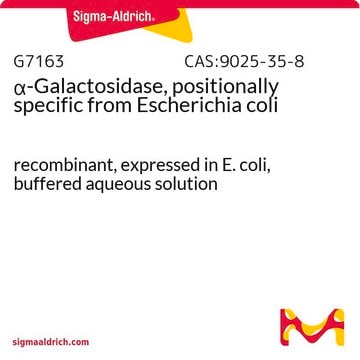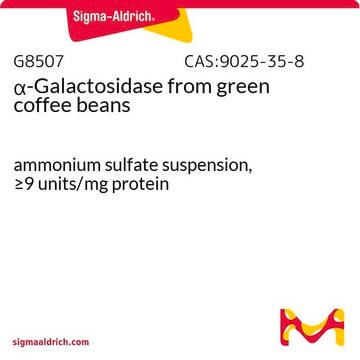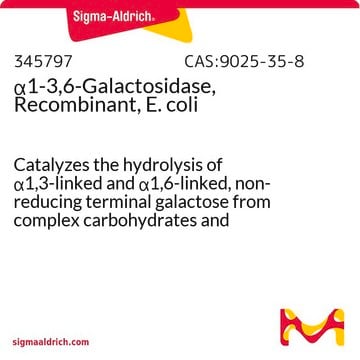G7673
α-Galactosidase I, Alkaline from Cucumis melo
Synonym(s):
α-D-Galactoside Galactohydrolase, Melibiase
Sign Into View Organizational & Contract Pricing
All Photos(1)
About This Item
CAS Number:
MDL number:
UNSPSC Code:
12352204
NACRES:
NA.54
Recommended Products
recombinant
expressed in E. coli
Assay
≥85% (SDS-PAGE)
form
lyophilized solid
specific activity
≥20 units/mg protein
mol wt
apparent mol wt ~84 kDa by SDS-PAGE
shipped in
wet ice
storage temp.
−20°C
General description
Alkaline α-Galactosidase I is a glycoside hydrolase, separated from the extracts of melon fruits. The activity of this enzyme is found to increase during the early stages of ovary development and fruit set.
Application
Alkaline α-Galactosidase I was used to assay enzyme activity with 2 mmp-nitrophenyl-α-d-galactoside as substrate at pH 6.5 to compare with the enzyme activity of α-Gal A isolated and purified from Sf-9 insect cells infected with a recombinant baculovirus encoding normal α-Gal A gene.
Biochem/physiol Actions
α-Galactosidase form I from melon may play a significant role in photoassimilate partitioning in sink tissue. The form I enzyme has a preferred activity with raffinose and significant activity with stachyose. A unique feature of this enzyme is that it exhibits weak product inhibition by galactose.
This enzyme shows a preference for raffinose and also activity with stachyose. Unlike other a-Galctosidases, this enyzme also shows weak inhibition by galactose.
Physical properties
This enzyme exhibits maximal activity between 30-37°C. Activity declines above 40°C.
Unit Definition
One unit will hydrolyze 1.0 μmole of p-nitrophenyl α-D-galactoside to p-nitrophenol and D-galactose per minute at pH 7.8 at 30 °C.
Physical form
The product is supplied as a lyophilized powder containing Tris-HCl buffer salts, DTT, EDTA, and NaCl.
Signal Word
Warning
Hazard Statements
Precautionary Statements
Hazard Classifications
Eye Irrit. 2 - Skin Irrit. 2 - STOT SE 3
Target Organs
Respiratory system
Storage Class Code
11 - Combustible Solids
WGK
WGK 3
Flash Point(F)
Not applicable
Flash Point(C)
Not applicable
Certificates of Analysis (COA)
Search for Certificates of Analysis (COA) by entering the products Lot/Batch Number. Lot and Batch Numbers can be found on a product’s label following the words ‘Lot’ or ‘Batch’.
Already Own This Product?
Find documentation for the products that you have recently purchased in the Document Library.
N Asano et al.
European journal of biochemistry, 267(13), 4179-4186 (2000-06-24)
Fabry disease is a lysosomal storage disorder caused by deficient lysosomal alpha-galactosidase A (alpha-Gal A) activity. Deficiency of the enzyme activity results in progressive deposition of neutral glycosphingolipids with terminal alpha-galactosyl residue in vascular endothelial cells. We recently proposed a
Gao et al.
Plant physiology, 119(3), 979-988 (1999-03-09)
The cucurbits translocate the galactosyl-sucrose oligosaccharides raffinose and stachyose, therefore, alpha-galactosidase (alpha-D-galactoside galactohydrolase, EC 3.2.1.22) is expected to function as the initial enzyme of photoassimilate catabolism. However, the previously described alkaline alpha-galactosidase is specific for the tetrasaccharide stachyose, leaving raffinose
Nir Carmi et al.
The Plant journal : for cell and molecular biology, 33(1), 97-106 (2003-08-29)
Raffinose and stachyose are ubiquitous galactosyl-sucrose oligosaccharides in the plant kingdom which play major roles, second only to sucrose, in photoassimilate translocation and seed carbohydrate storage. These sugars are initially metabolised by alpha-galactosidases (alpha-gal). We report the cloning and functional
Xiao-Liang Pan et al.
The journal of physical chemistry. B, 117(2), 484-489 (2012-12-20)
The enzyme α-galactosidase (α-GAL), a member of glycoside hydrolase family 27, catalyzes the removal of a nonreducing terminal α-galactose residue from polysaccharides, glycolipids, and glycopeptides. α-GAL is believed to have the double displacement retaining reaction mechanism. In this work, the
Junpei Zhou et al.
Journal of microbiology and biotechnology, 22(11), 1532-1539 (2012-11-06)
The α-galactosidase-coding gene agaAJB13 was cloned from Sphingomonas sp. JB13 showing 16S rDNA (1,343 bp) identities of < or =97.2% with other identified Sphingomonas strains. agaAJB13 (2,217 bp; 64.9% GC content) encodes a 738-residue polypeptide (AgaAJB13) with a calculated mass
Our team of scientists has experience in all areas of research including Life Science, Material Science, Chemical Synthesis, Chromatography, Analytical and many others.
Contact Technical Service








